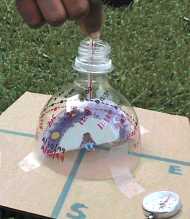| May 13, 1999 |
|
Previous Next |
||
|
|
||||
|
| ||||
 Now, let's look at some data. The photo shows a 'solar track' (in red) that I made with my sphere on April 20th, and a track (in black) made on May 5th with the help of Ms. Sanchez's 8th grade class at Sierra Vista Middle School in Hacienda-La Puente. Both tracks include the time at which each measurement was made, as well as sunset and sunrise times. In case you were asleep at sunrise (as I was!), you can get the data from the weather report in the Los Angeles Times or at the U.S. Naval Observatory’s Web site.
Now, let's look at some data. The photo shows a 'solar track' (in red) that I made with my sphere on April 20th, and a track (in black) made on May 5th with the help of Ms. Sanchez's 8th grade class at Sierra Vista Middle School in Hacienda-La Puente. Both tracks include the time at which each measurement was made, as well as sunset and sunrise times. In case you were asleep at sunrise (as I was!), you can get the data from the weather report in the Los Angeles Times or at the U.S. Naval Observatory’s Web site. | ||||
|
Based on the sunrise and sunset times, the length of the day increased by 27 minutes during the 15 days between the two measurements. You can see in the photo that the track of the Sun also changed. The track from May (in black) was higher on the sphere than in April (in red). This means that the Sun is currently getting higher in the sky each week! You can measure the exact height of the Sun (in degrees) using the protractor in the celestial sphere. Some of you have already started sending in your angle data. But, like most scientists, I love to have lots of data, so keep sending it in! | ||||
|
I also like more questions (as you know by now!). When I was visiting Mr. Saber's 5th grade class at Willard Elementary School in Pasadena, several students mentioned that they have relatives in other places, such as Chicago and Mexico, and wanted to know if the length of the day was the same there as in Los Angeles. | ||||
Try this! Many of you probably have relatives and friends in other parts of the world, too. And you have given me an idea: wouldn't it be fun to ask people all over the world to collect data on the Sun? The simplest thing would be just to ask your relatives or friends how long their days are (make sure you find out which day they measured). It would be even more interesting if they were to build a celestial sphere and take measurements with the protractor. If they need directions, they can get them from the Sun Spot in Whyville. They can also enter their data there. | ||||
| Whyville Square | Introduction | Series 1: Spinning | Series 2: About Time | Times Building Entrance | Log Out |